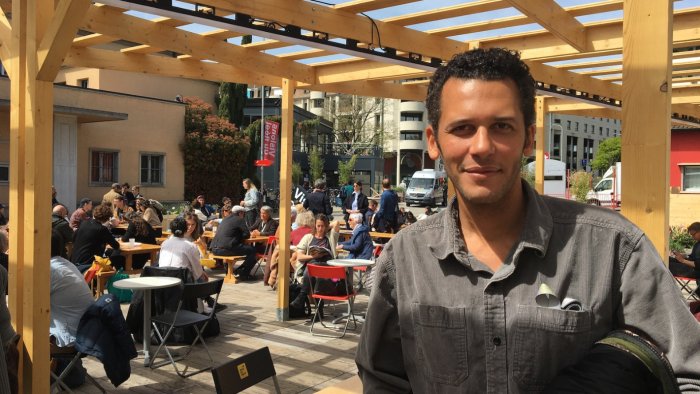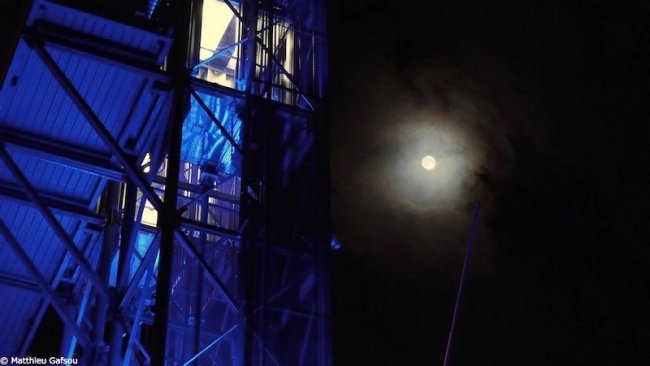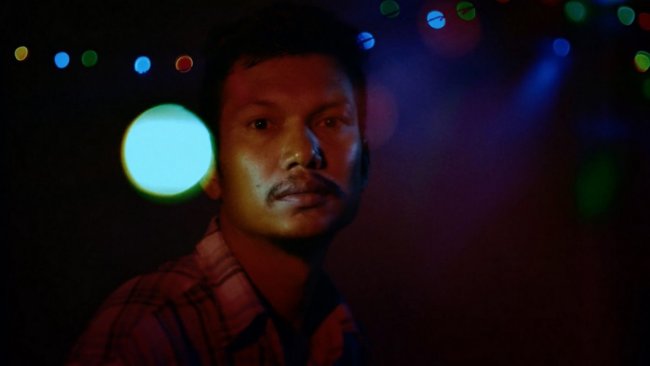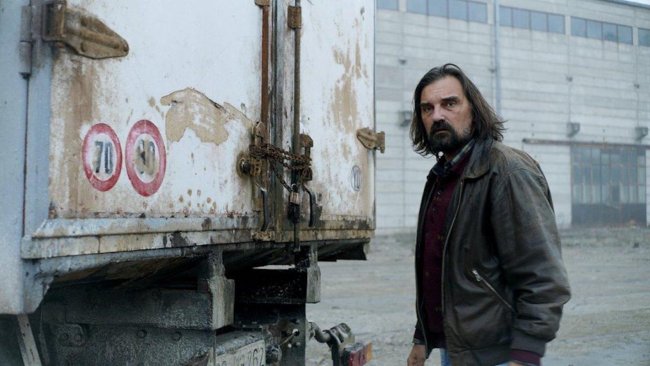James N. Kienitz Wilkins | Still Film
For the international premiere of James N. Kienitz Wilkins’ «Still Film», Filmexplorer discusses the film through an experimental text and an audio interview with the filmmaker himself (hear the podcast).
[…] Like a reality-check, «Still Film» introduces a grain of reality in the cinema memory – of films, in films. It makes this reality explode the delusional machine of cinema nostalgia. It exposes the dumbness of the common man, so liberating us from all these innocent heroes of cinema. Good-bye Tom [Hanks], «Still Film» is a film of emancipation.
Text: Giuseppe Di Salvatore | Audio/Video: Ruth Baettig

Podcast
James N. Kienitz Wilkins | Still Film
After having discussed his This Action Lies five years ago, Filmexplorer meets James N. Kienitz Wilkins in Nyon for the premiere of his Still Film at Visions du Réel 2023 and continue the exchange on his filmmaking. Interview: Giuseppe Di Salvatore | Editing: Ruth Baettig
Find a list of all our Podcasts here.
Speaking about cinema – this is what Still Film does. Or, better yet, speaking about cinema through film slides, through a speech about film slides. Film slides that could be film stills, which actually are photographs. Professional photographs shot by film set photographers, or unit photographers, or still photographers... James N. Kienitz Wilkins’ Still Film is a film made of still photographs, but it is not a silent film, for the film speaks about the still photographs, and the still photographers. The film also eventually speaks of stillness, the stillness of cinema, when cinema declines into its glorious sunset, in the Eighties and Nineties.
Is speaking about a film that speaks about films redundant? Or is it a way to continue speaking about films, about cinema, about its stills and its stillness? Would James need this continuation? Or has he already exhausted the topic? Exhausted and energised, I am listening to his warm and precise voice playing four roles at high speed. A high speed that creates a specific flatness – the Modernist one of Jonas Mekas and the high speed sequence of images of the experimental film of the Sixties? Here the experiment is with the voice, in a conversation without pauses or actually with two main pauses, which part the film into three sections. Four witnesses and three sections for a conversation that is definitely more than a chat. They (four times James) speak as lawyers and witnesses, lawyers who witness. «It is not a criminal inquiry but a deposition», a legal deposition. One hour of flowing words, almost no room for silence, no room for sound stillness, while the film stills are gliding by at a constant pace. Certainly slower than the words, and never illustrating said words. The witnesses mention films, which come only later, or have already passed on the screen. All these images passed on cinema screens, a long time ago, again and again, becoming more and more old-fashioned, vintage, cinephilic.
“Cinephilic” is not a proper word. And James do not like the word “cinephilia”. Or, at least, it is not really what he aims for through this carousel of film slides. They are delivered as amused relics, yet discussed as criminal evidence. Evidence of a cinema world that is revolved. Each mention is distant from its photographic source, or image reference. Distance is the inherent, invisible word that breathes between the lines of the close dialogue. I won’t just “continue” the close dialogue if I find a distance from Still Film. Could it be the distance between text and images, voices and photographs, mentions and stills? This is the distance within the film, the distance that makes the film breathe. My distance, the distance from the film won’t actually be so far from the distance within the film. My distance will be a gesture of slightly shifting the perspective. Not the distance of the observer, not the analytic perspective on Still Film, and still a sort of continuation of it, of its conversation, but with small gestures of shifting. It’s also the question of being faithful to my cinema armchair, which is not James’ editing chair.
The one in the cinema armchair is five years older than the one in the editing chair. He can still recognise most of the cinema references in Still Film, but only as vague memories. The one in the armchair watched another television as a child, he has plenty of older movies in his eyes. The festival of American films of the Eighties and Nineties is an exotic journey for the one in the armchair, while for the one in the editing chair it is a visual grammar that he has not chosen, it’s the common ground of his American childhood. This is why I like his humour, even more prominent to the extent that it emerges in the context of a legal deposition. This humour creates a distance that gets close to my distance. When I hear him smile behind the words, I feel that we are both on the same cinema armchairs, looking at the revolved stills and exercising our memory. This is a double exercise: the memory of the films and the memory of the slides when we hear the voice speaking about the films. Because, I’ve already said it, the slides are distant from the mentions of the voice, and the slides also come back a second and a third time on the screen. For this second memory exercise, we are also together, we are both on the cinema armchair, because the memory that is created within the film is the common ground for everyone who is sitting in cinema armchairs, independently of the background, of the different childhoods, of the degree of cinephilia, of the specific cinema memory. Still Film can go back to a common ground of cinephilic memory, but this is not the point – yeah, again, James does not like the word “cinephilia”. Still Film pushes its own common ground forward, the common ground of recurring film slides. Is a film still even stiller when it appears a second and a third time on the screen? Is a repeated still stiller yet?
A repeated film still is like twice in the past. Twice a still, a still-still, and the film becomes a past-past film. Is this a sweet matter for nostalgia? Or, on the contrary, is it a way to get rid of nostalgia? James would prefer the second reading. Yes, because the effective common ground is only within the film, and Still Film is now. The Eighties and Nineties are contemporary territories. They are the contemporary territory of James’ childhood, from 1982 to 2001. 2001, a peculiar end of childhood for an American 18 year-old young adult. Is this choice a thesis? Is the legal deposition a way to collect evidence for a crime to come? Not, this thesis would be the result of paranoia, that is the sport for people that are short of meanings. Cinema has something to do with crime, almost all actually, not necessarily with paranoia, and cinema regurgitates meanings, but the Eighties and the Nineties are rather tired of meanings, they are not seeking them. Already too many people had cried for the death of cinema, and spoken of post-cinema. This span of time is James’ childhood but also the time of after-cinema, at least in the sense of the afterimage – of which cinema itself is done. It is the time of the cinema relics, of the cinema quotes, of the cinema as a vintage object, as the place for nostalgia. This seems to be James’ thesis. It is not only the private question of his own childhood, it is the public question of a certain cinema as the place for nostalgia, nostalgia for youth and its innocence, for the innocence of childhood. The cinema of his childhood is the cinema that celebrates the nostalgia of Childhood. This is the evidence the four witnesses are collecting.
«When we participate in it, we are already losers». From the point of view of James’ thesis – if it is one – I seem to understand this suggestive sentence. In looking at Still Film we indirectly participate in a nostalgic cinema, of which we cannot be nostalgic. On the contrary, through this participation and the awareness of being losers, or having been losers, we would like to get rid of this kind of cinema. More than a celebration, Still Film will look like the obituary of this kind of cinema, the obituary of childhood as principle of innocence. The secret crime that the witnesses are collecting the evidence for is nothing but the assassination of innocence through its exhibition, as something that is constantly celebrated.
This is the obituary of the most innocent figure in the history of cinema, the common man – and his representation of the common ground, of the illusion of a common ground. It’s not James Stewart as Hitchcockian passepartout, as pivot for the viewer’s identity transfer (Fellini’s Mastroianni would equally work), but it could have been, or is, indirectly. James’ obituary focuses on Tom Hanks, the common man of the Eighties and Nineties, who cannot but (nostalgically) refer to James, I mean, James Stewart, not James N. Kienitz Wilkins – but in his childhood I can well imagine the younger James experiencing, or suffering, the identity transfer with the older James… Now, Tom would ideally be assassinated through a cinematic suicide or – this is James’ phantasy – through a real suicide on a cinema set, when playing the never-celebrated John Bramley, the unit photographer, or still photographer, who has also been his still photographer, the still photographer of Tom Hanks himself. Here is a way to pay homage to still photographers, which James does by also referring to Linda R. Chen. However, James does not imagine the assassination of her friend and colleague, the director Quentin Tarantino, probably because in this case the common man is not embodied by Tarantino but by Tarantino’s ideal viewer, or more precisely the common man. Should be all of us assassinated, at least “a bit”, in the crime that Still Film seems to prepare, or imagine, or presuppose?
Yes, «this is not a criminal inquiry but a deposition», a legal deposition, and the still photographers – John, Linda, and many others – are celebrated as they were hidden Socrates helping us to recollect memories and create unsuspected connections. In making a fake of a fake, that is a photograph out of a film still, they build a still cathedral that recalls to us the most delusional of celebrations, the celebration of youth and innocence. The homage James pays to them is a homage to their non-celebrated real job, or profession. Like a reality-check, Still Film introduces a grain of reality in the cinema memory – of films, in films. It makes this reality explode the delusional machine of cinema nostalgia. It exposes the dumbness of the common man, so liberating us from all these innocent heroes of cinema. Good-bye Tom, Still Film is a film of emancipation. Emancipation towards adult cinema, or cinema of adulthood.
How would it look? Still like a film? Like Still Film itself?
This article contains a third-party video. If you would like to watch the video, please adjust your settings.
Info
Still Film | Film | James N. Kienitz Wilkins | USA 2023 | 72’ | Visions du Réel Nyon 2023
First published: May 08, 2023



